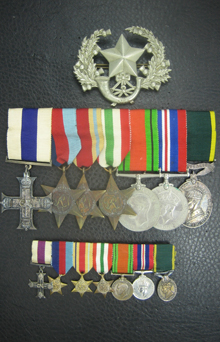
MILITARY CROSS, G.VI.R. REVERSE OFFICIALLY DATED ‘1943’; 1939-45 STAR; AFRICA STAR; ITALY STAR; DEFENCE AND WAR MEDALS 1939-45; EFFICIENCY MEDAL, G.VI.R., 2nd ISSUE, TERRITORIAL ‘LT. J. MCK. PORTER. M.C. CAMERONIANS’ MOUNTED AS ORIGINALLY WORN, WITH SET OF CORRESPONDING MOUNTED MINIATURES.
M.C. London Gazette The original recommendation for an ‘immediate’ award states:
'On the 2nd August 1943 the battalion was holding an important position at Sferro bridge. During daylight movement was reduced to an absolute minimum due to enemy action. Two enemy MG post had been located within 1000 yards of the BN right flank. It was decided to kill or capture the personnel of these posts. Lt Porter with 19 men was ordered to carry out this task by means of a daylight raid. By skilful manoeuvring of his command, he succeeded in surprising the first post capturing four Germans. Having done this he quickly moved against the second which he also overran capturing a further five Germans and one officer. Several Germans withdrew from the position. Lt Porter's command had now been reduced to ten men owing to casualties and men sent back as escort to prisoners. Lt. Porter commenced to consolidate his position but was almost immediately subjected to grenade attack by some Germans hidden in some nearby cactus. When dealing with this party of enemy, he was then attacked in the flank by about 20 Germans led by an officer. Lt. Porter shot the leading man with his revolver, where upon the remainder took cover. As the party had now been reduced to 7 men, Lt porter decided to withdraw. This he succeeded in doing despite the fact that it entailed movement over ground exposed to enemy fire. During the operation Lt. Porter, who was also wounded in the arm, exhibited leadership of the highest order. By his personal example and coolness under fire, he inspired his men in an extremely difficult situation. The success of this operation was entirely due to the determination and devotion to duty of Lt. Porter. As a result two German machine-gun posts were knocked out in daylight, one officer and 9 O.Rs captured and 7 Germans killed.'
John McKenzie Porter was born in Accrington on 21 October 1911 and pre-war was a newspaper correspondent; many articles of his can be found in The Daily Mirror, 1936-38. He was commissioned 2nd Lieutenant (177680) Cameronians (Scottish Rifles), on 15 March 1941 and having served in North Africa and been advanced to Lieutenant in September 1942, was serving with ‘A’ Company the 2nd Battalion during the invasion of Sicily (Operation Huskey) in July 1943:
https://en.wikipedia.org/wiki/Allied_invasion_of_Sicily
He was awarded the Military Cross for his gallantry in leading a raid on German machine gun positions in the aera of Sferro Bridge on 2 August 1943. During the raid, in which he led 19 men from his company, he captured 1 German Officer and 9 men, killing a further 7, personally killing one with his revolver. He was slightly wounded himself and his command had been reduced to 7 men by the time they returned. Though his recommendation for the Military Cross notes he was wounded during the action, it appears the wound was not serious for he is still shown as present in the War Diary entry for the end of August 1943.
Porter was detached from the battalion to 13th Infantry Brigade Rear Party at the end of October 1943 and was still detached at the end of December.
His obituary and other articles say he was wounded at Monte Cassino or the ‘Garigliano River battle’ (same battle), one article suggesting he was wounded by four bullets at Monte Cassino.
The battalions War Diaries for 1943 are available online and those for July-December are with the research. The Diaries for 1944 have not been digitalised yet but a search of these will show when Porter returned from detachment and when he was wounded. This will be at some point between January and May 1944.
Having recovered from his wounds, he was medically regraded and transferred to British Intelligence, serving in Rome, Athens and Vienna until discharged in 1946.
Post war he was back as a newspaper correspondent, initially as Paris Correspondent for Kemsley Newspapers (owned The Times, Telegraph etc) 1946-8. He was awarded the Efficiency Medal, London Gazette, 23 May 1952. Emigrating to Canada, he continued to work in publishing and died on his 95th birthday, 21 October, 2006:
https://www.imdb.com/name/nm8107832/bio/?ref_=nm_ov_bio_sm
His obituary noting:
“Fleet Street editor, film critic and feature writer prior World War II. Brilliant record as an infantry officer in the Italian campaign, wounded at Cassino, awarded the Military Cross. Served through 1946 with British Intelligence Rome, Athens and Vienna. Paris correspondent Kemsley Newspapers 1946-1948. Emigrated to Canada. Prolific profiler for Maclean's 1948-1962. Columnist, arts critic at The Telegram and Toronto Sun 1962-1990. Author biography Prince Edward Duke of Kent 1962.”
Condition GVF. Sold with the recipients Cameronians Glengarry badge (private purchase?) and a patch. Also copy research (digital) including Gazettes, recommendation and War Diaries for 1943.